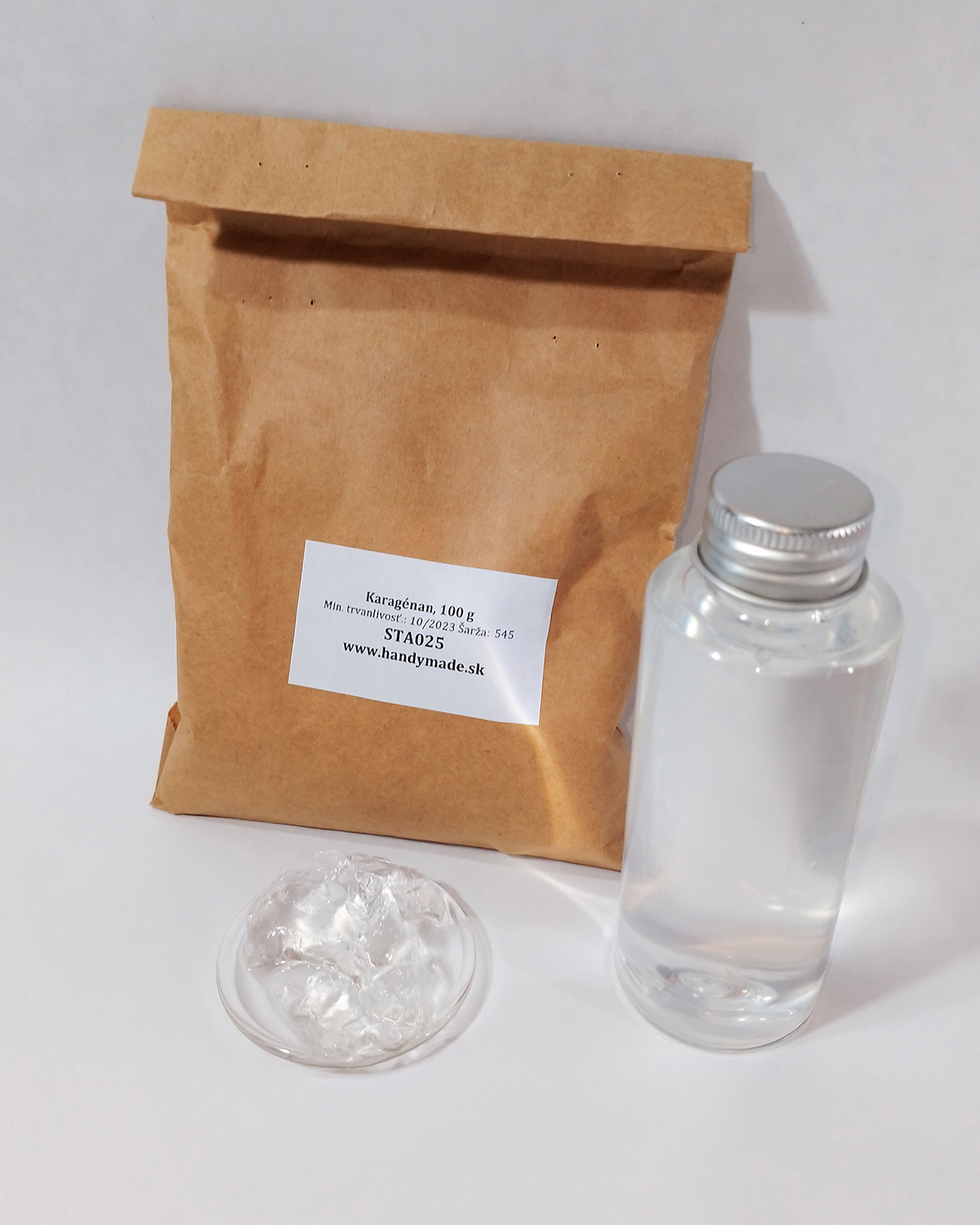Comparison of natural gums
Comparison of natural gums is a great tool for knowledge acquisition before creating gel cosmetic products
Have you wondered how to create water-based gels, shampoos or various shower products in gel form? The answer to these products is natural gums. However, natural gums hold much more than the ability to create a gel from water. Let's take a closer look at the properties of different natural gums and compare them.
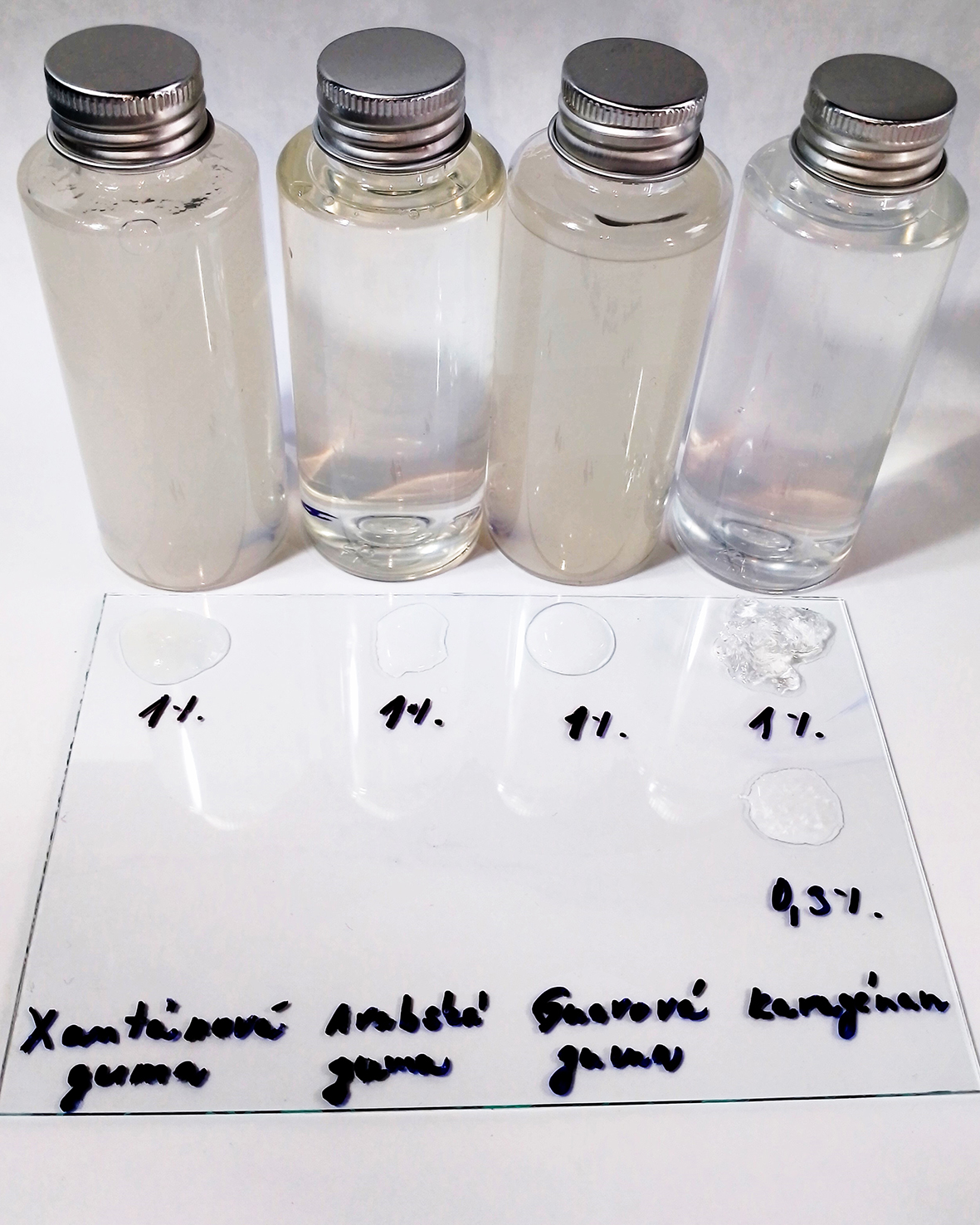
NATURAL GUMS AND THEIR USES
Natural gums are usually carbohydrate-based substances that swell in an aqueous environmentas they form interlocking networks and thus increase the viscosity of the final product.
So what can you use natural gums for? First of all, natural gums are used to form water-based gels. Natural gums are added to water or hydrolates or other aqueous solutions and transform them into gels. Of course, there are some limitations, for example, some gums dissolve only when heated, whether they are unstable at certain pH values, or they may not form gels at all and have other applications.
Another characteristic of natural gums is the ability to improve the stability of emulsions or to give emulsions a unique gel-like consistency. It is on the combination of the emulsion (i.e., the combination of water and oils by an emulsifier)
in conjunction with natural gums is the basis of body yoghurts.
Natural gums also have caring properties. Some natural gums are able to improve the condition of the hair and are also used as active ingredients. In addition, natural gums also affect the texture of products or their feel on the skin. Natural gums can be obtained from plant material or algae, some gums are also prepared biotechnologically, their producers are various microorganisms.
NATURAL GUMS - COMPARISON OF GEL-FORMING PROPERTIES
To compare the gel-forming properties of selected natural gums, we prepared solutions of the following gums
containing 1 % natural gum, 2,5 % glycerine, 1 % preservative Euxyl PE 9010 and 95,5 % distilled water.
All solutions/gels were prepared in the same way, by mixing the powdered natural gum
with glycerine to form a viscous slurry, then distilled water was incorporated into this mixture with stirring and the preservative was added after the gel was formed. The only exception was carrageenan, the aqueous solution of which must be heated to dissolve and then form a gel after the mixture has cooled. In this case, the preservative was added after cooling to room temperature.
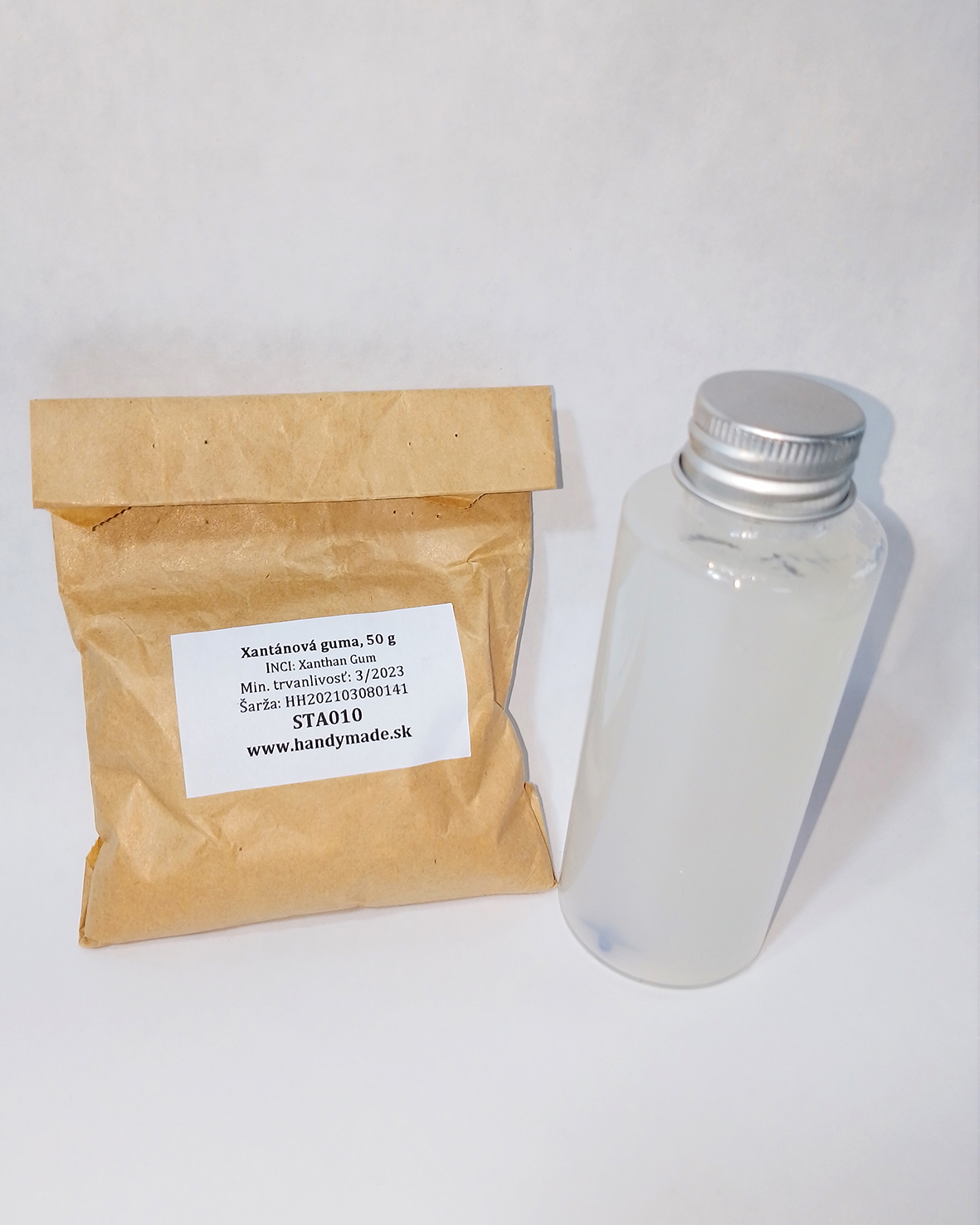
XANTHANE RUBBER
Xanthan gum is a great natural gum for beginners as it is able to form a gel effectively
in cold or hot water and is stable over a wide pH range. If your product fails using xanthan gum, the fault is probably not with the xanthan gum, but with the other raw materialsn or procedure, because xanthan gum can handle a wide range of conditions, including vigorous mixing, to produce very stable emulsions. Xanthan gum combines well with galactomannans such as konjac powder, the combination of the two substances will cause a significant increase in viscosity.
This natural gum is obtained biotechnologically, produced by Xanthomonas campestris. The disadvantage of xanthan gum is that products made with it can be more difficult to spread and it leaves a slightly sticky feeling on the skin.
Xanthan gum contains negatively charged groups, i.e. it is classified as an anionic gum, therefore such negatively charged gums do not usually combine well with positively charged substances such as cationic tensides often used in hair cosmetics. On the other hand, anionic gums form gels well in aqueous environments for use in shampoos, shower gels, skin cleansing gels
etc. Xanthan gum is thus well combinable with amphoteric, nonionic or anionic ingredients.
XANTHAN GUM - TEST
Xanthan gum formed a relatively thick gel at a concentration of 1 %. The gel was not clear and transparent, but rather milky in colour and opaque. Its texture was not the finest (compared to guar gum), yet this did not affect the spreading of the gel on the skin, the gelthe gel was evenly spread, therefore, for the production of home cosmetics, it is more of an appearance defect, which, however, does not interfere with the functionality. However, it does take a little longer for the xanthan gum gel to fully spread on the skin until it is lost than with the guar gum, and there is a slightly sticky feeling on the skin until fully absorbed.
Xanthan gum has the advantage of forming stable gels even in a wider pH range, including acidic environments, so it is suitable for for thickening shampoos and other products containing glucosides which have an alkaline pH and need to be neutralised to the physiological pH of the skin (4.5-5.5).
Xanthan gum is therefore suitable for beginners, already in small doses (1%) it forms a relatively thick geltherefore, if you want shampoos or shower gels that flow easily from the bottle, use lower doses.
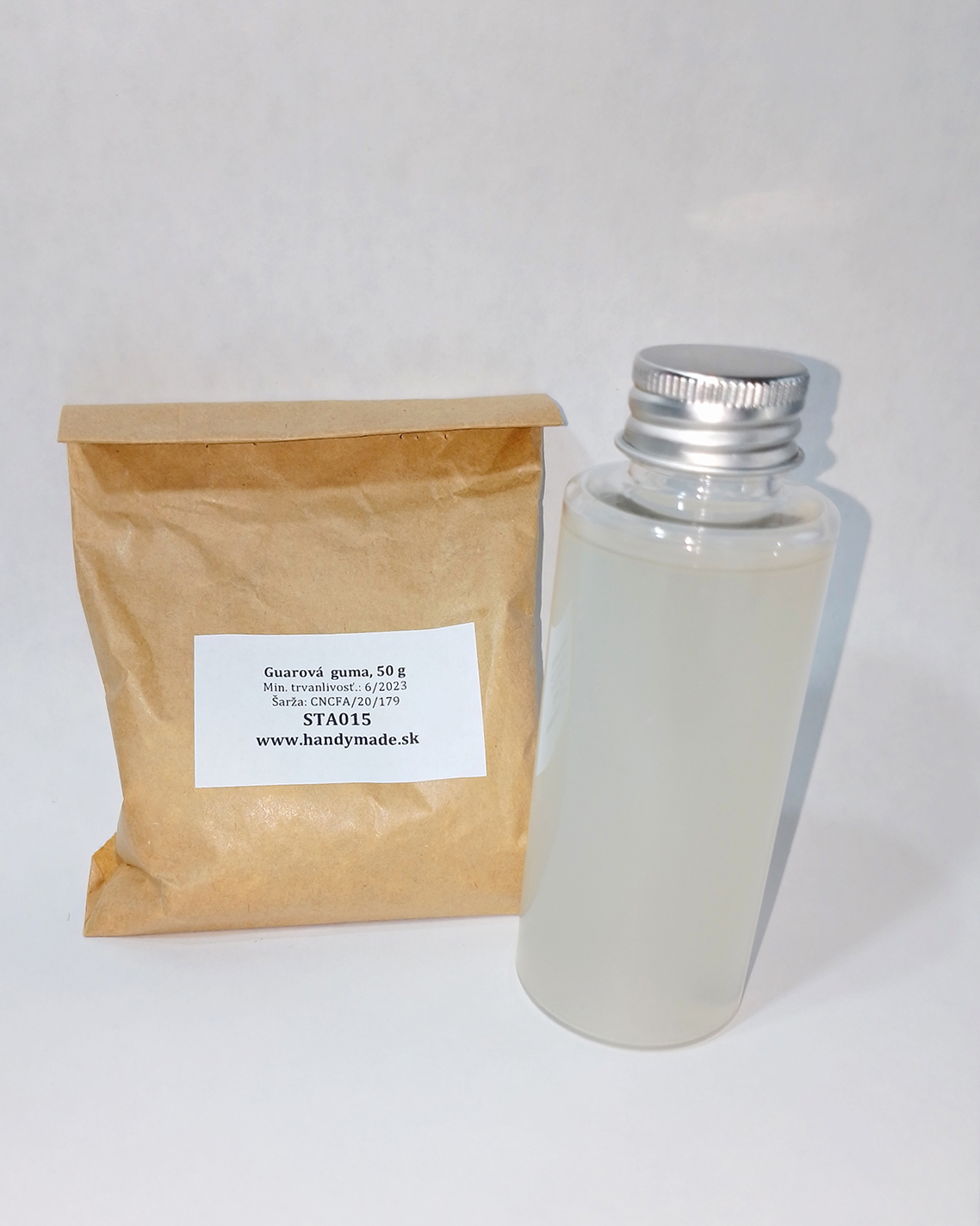
GUAR GUM
Guar gum is a thickening agent derived from the seeds of Cyamopsis tetragonolobus. Guar gum hydrates easily in both cold and hot environments and forms fairly thick gels. Guar gum is classified as a non-ionic gum and so is combinable with other raw materials regardless of their charge. However, there is also a cationic guar gum which has different properties, so the two substances cannot always be confused with each other.
GUAR GUM - TEST
Another gum that thickens aqueous solutions well is guar gum. Like xanthan gum, guar gum does not form transparent solutions, but rather slightly turbid mixtures. However, the advantage over xanthan gum is that the resulting gels have a very smooth, pleasant texture that not only feels good to the touch , but also looks very good.
The disadvantage is the slightly lower stability compared to xanthan gum, also guar gum produces gels of lower viscosity at a concentration of 1 %, i.e. you will therefore need a slightly higher dosage than with xanthan gum to get a more gel-like consistency.
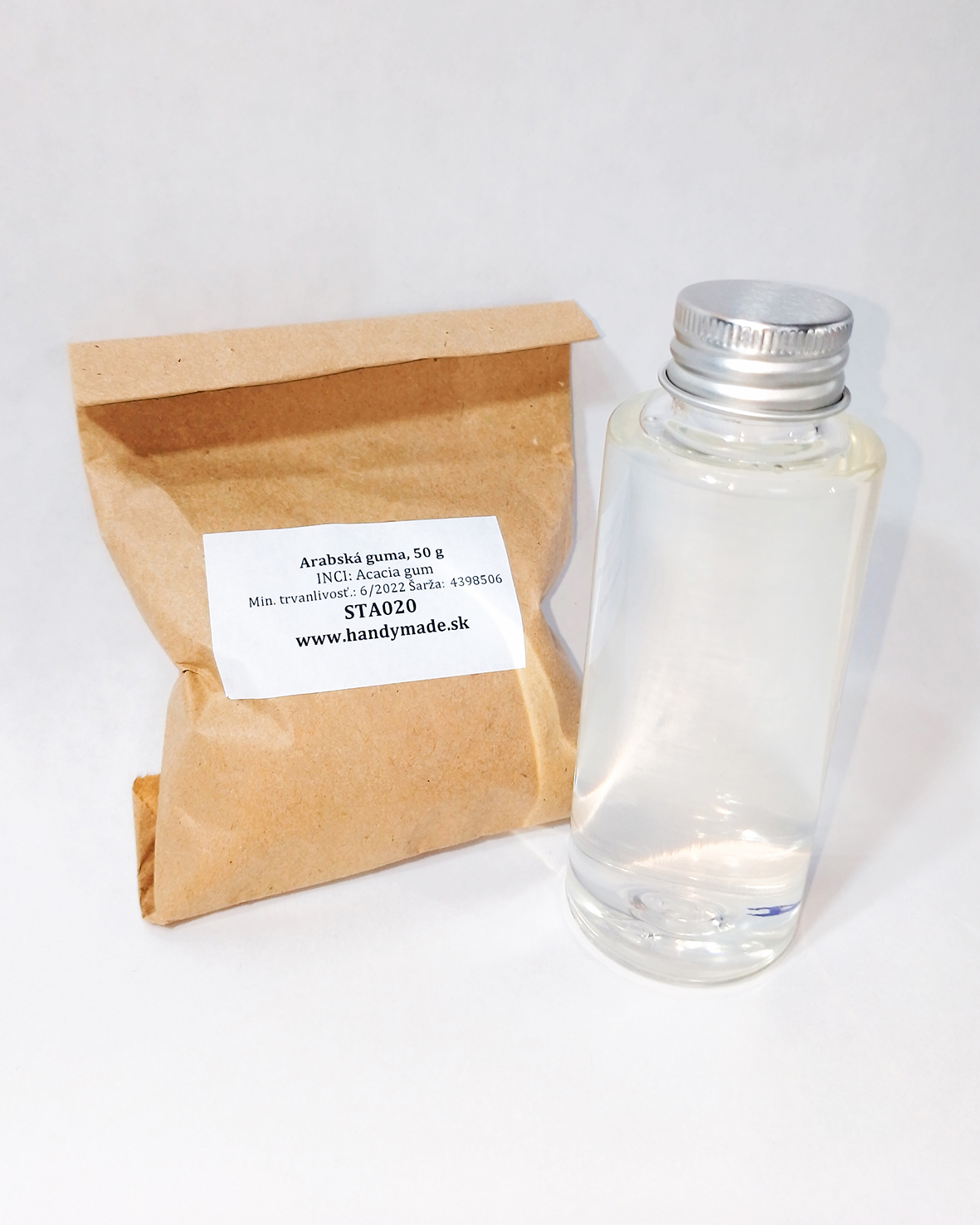
ARABIC RUBBER
Gum Arabic is obtained by extraction from the Acacia senegal tree and can also be found under the name Acacia gum. This gum is not known for its strong gel-forming properties, it does not form thick gels, but it is able to stabilize emulsions as it interacts with lipids. In addition, it produces a soft feeling on the skin,
thus improving the texture of the products. This gum is sometimes used in decorative cosmetics because it improves the adhesion of dyes to the skin.
If you are working with gum Arabic and have difficulty dissolving it completely in cold water, you can heat the mixture to 70 °C until the gum Arabic is completely hydrated. Once cooled, the viscosity may change. Usually, a more significant increase in viscosity is obtained when this gum is used in a concentration of at least
40 %. It is an anionic gum which does not combine well with substances with a purely positive charge.
Due to its ability to interact with lipids, gum Arabic facilitates the binding of oils to water without increasing viscosity. This is particularly useful if you want to imbibe small amounts of oils in aqueous solution, for example, combining essential oils with aqueous solutions while maintaining a low viscosity, such as in toners and sprays. Try using a 3:1 or 4:1 ratio of gum Arabic to oils.
GUM ARABIC - TEST
Gum Arabic was the only gum in our test that did not thicken the prepared aqueous solution.
This makes gum Arabic unsuitable for thickening products or forming gels when used alone. Arabic gum is therefore worth using in combination with other natural gums to create a gel
and thicken the product.
In a test of gum Arabic, a clear liquid was obtained, therefore gum Arabic does not cloudy the solutions, on the contrary, it provides transparent solutions.
CARAGENAN
Among the anionic gums derived from algae is carrageenan. Specifically, carrageenan is obtained from the red seaweed Chondrus crispus and is a widely used ingredient not only in cosmetics, but especially in the food industry. It is a good thickener and partly an emulsifier, and so improves the binding of oil
and aqueous raw materials.
Carrageenan helps to thicken products, creating thick, viscous emulsions. In addition, it improves skin hydration as it helps to retain more water in the skin.
CARRAGEENAN TEST
Carrageenan is a plant-based alternative to animal gelatine, and its properties correspond accordingly. Carrageenan must first be heated in a water bath until dissolved, which is achieved at around 70 °C. Once dissolved, the mixture must be allowed to cool. It is only when the mixture has cooled completely that it will set, so sometimes you have to wait several hours, depending on the temperature of the place where the mixture is cooling, to get a solid mass.
The advantage of carrageenan is that it thickens intensely even at low concentrations. At 1 %, a solid jelly, similar to the gelatine on cakes, is obtained when cooled. It is therefore preferable to use a lower concentration to thicken the products, as the strength of this jelly was too high for any product to be cast.
At a concentration of 0,3 % it was already possible to stir the mixture with a stick. However, the disadvantage was that during mixing, the solid portion of the jelly was slightly broken up into smaller parts, so that we did not get a homogeneous gel, but rather a mixture of lumps of jelly which not only did not look good to the eye, but also were not the best to work with.
Overall, carrageenan has the advantages of providing a fairly clear and transparent solution, the disadvantage lies
is the need to heat the mixture to dissolve the carrageenan, which adds an extra production step. At the same time, the result is not a homogeneous gel but a mixture of lumps, so either use very low concentrations of around 0.1% or combine the carrageenan with another natural gum for better properties.
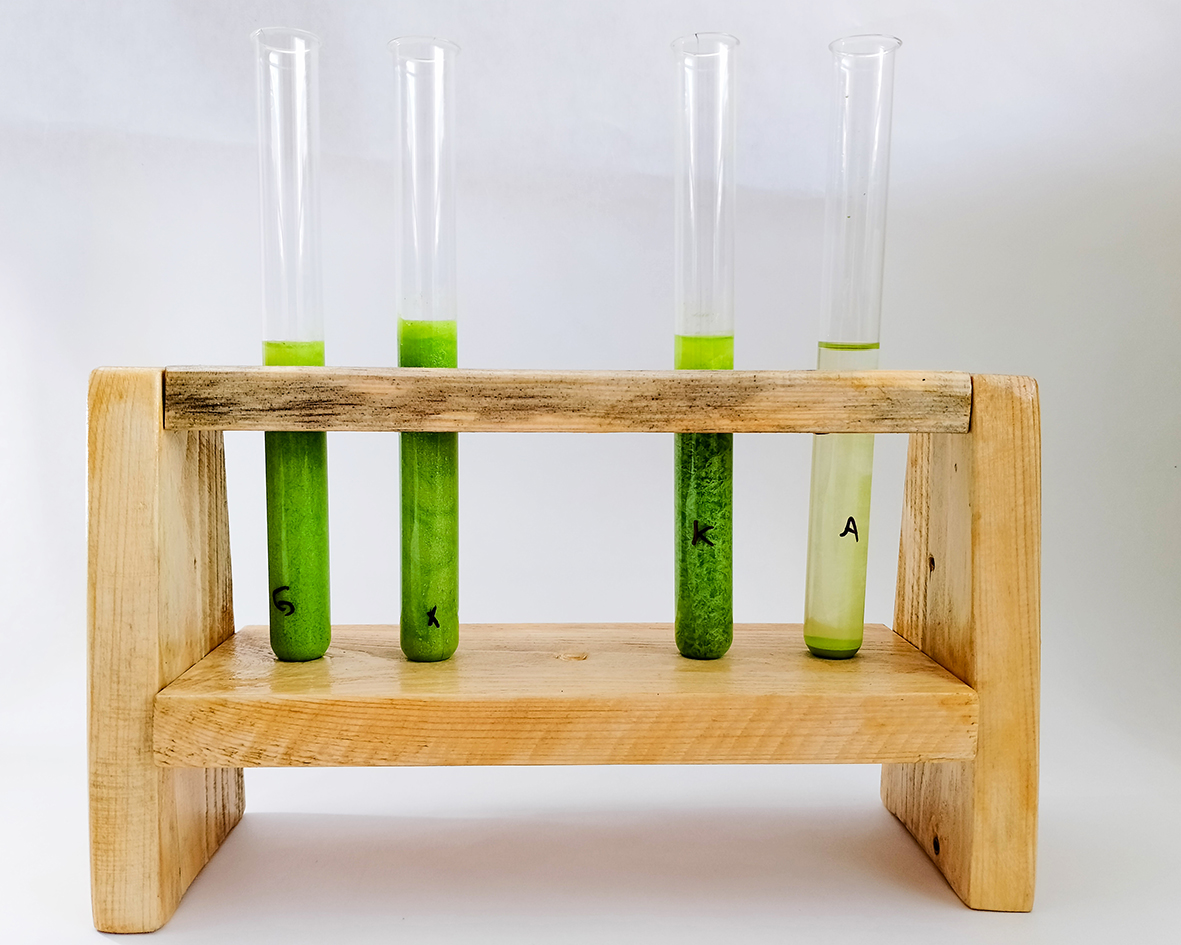
NATURAL GUMS AND MICA POWDERS
When making shampoos or shower gels, many of us occasionally reach for different colouring agents, the most common being mica powders. Mica powders are not only shimmery, but are also available in a wide variety of colours to spice up your product. Would you like to prepare a palette of brightly coloured products too? Then you certainly don't want your chosen mica powder to sink to the bottom of the product after a while. That's why we looked at the sedimentation test of mica powder in our prepared gels and natural gum solutions.
We followed a similar procedure to the previous test. 1 % solutions of natural gums were prepared
with the exception of carrageenan, which was used at a concentration of 0,3 %, since at 1 % it gives too stiff a jelly,
into which it would be impossible to incorporate the mica powder. Also, the 0,3 % carrageenan solution was heated to dissolve this thickener.
Subsequently, 0,5 % of green mica powder was added to the solution and a milk frother was used to disperse it evenly in the mixture. To facilitate the dispersion of the mica powder, this dye can be added already to the glycerin and natural gum mixture before adding the water.
10 g of this mixture was poured into test tubes and allowed to stand upright for 72 hours to observe any settling of the mica powder to the bottom. The results refer to the respective percentage of natural gum used (1 % and 1 %, respectively). 0.3 % for carrageenan), and so using a lower concentration of natural gum may not give the same result (the gel may not be sufficiently viscous and the mica powder will settle to the bottom).what were our findings? Read below!
XANTHAN GUM AND MICA POWDER
When using xanthan gum, quite good results were obtained when combined with mica powder. The mica powder did not settle to the bottom, slight sedimentation after 72 hours was only observed at the top of the gel column, however if the mica powder werepart of the cosmetic product, this phenomenon should not be a major problem as there is also occasional mixing during handling.
Overall, the mica powder did not sit on the bottom, therefore it is possible to combine xanthan gum well with mica powders to achieve coloured products.
GUAR GUM AND MICA POWDER
Another gum that combines well with mica powders is guar gum. Again, the mica powder did not settle to the bottom, the slight sedimentation on the top of the gel column will be negligible when using the product as there will also be slight mixing by handling the product. The mica powder was dispersed very evenly, in this respect guar gum proved to be the best gel forming agent for the impregnation of the mica powder. The gel was uniformly coloured, overall appearing even slightly more homogeneous than that of xanthan gum.
GUM ARABIC AND MICA POWDER
Since the gum arabic did not thicken the prepared solution at all, as we expected the mica powder was not evenly dispersed and the mica powder sedimented to the bottom.
CARRAGEENAN AND MICA POWDER
Some dispersion of the dye was observed when mica powder was used with the carrageenan gel, however, as the solution contained larger pieces ofcarrageenan, the mixture was not uniform and homogeneous and so the mica powder was not as evenly dispersed as in the case of the xanthan gum and guar gum gels. Also, a more pronounced sedimentation was observed at the top of the gel.
Since the carrageenan in our case (0,3 % carrageenan in solution) did not form a completely homogeneous gel even after mixingwith a mixer/milk frother, it was not possible for even the mica powder to be perfectly and uniformly dispersed.
COMPARISON OF NATURAL GUMS - CONCLUSION
We believe that our comparison of natural gums has helped to broaden our horizons and brought more insights.
Did our post clarify some questions for you about creating natural cosmetics in gel form?
If you have any experiences and insights of your own that would provide further new information on this topic, please feel free to email us at marketing@handymade.sk
Many thanks to Ivana Jačalová for her comprehensive contribution.
Until we see you again for the next article or tutorial, don't stop creating natural cosmetics.
Until the saponification, my friends.

